Report: Applying Economic Principles to Work in Financial Services
VerifiedAdded on 2020/11/23
|17
|4299
|249
Report
AI Summary
This report delves into the application of economic principles within the financial services industry. It begins with practical exercises, examining price elasticity using the arc method and analyzing its implications. The report then explores market structures, contrasting perfect competition, monopolistic competition, oligopoly, and monopoly. A three-column matching activity and word puzzles further reinforce key concepts. Part B applies these principles to real-world scenarios, defining and analyzing the current account deficit (CAD) and its economic factors. It includes balance of payments calculations and a discussion of the Reserve Bank of Australia's duties and responsibilities. The report also compares top Australian banking groups and evaluates the impact of recent events, such as the Queensland floods, on the financial sector, and concludes with corporate law and regulations in Australia and an overview of the main economic goals of modern governments.
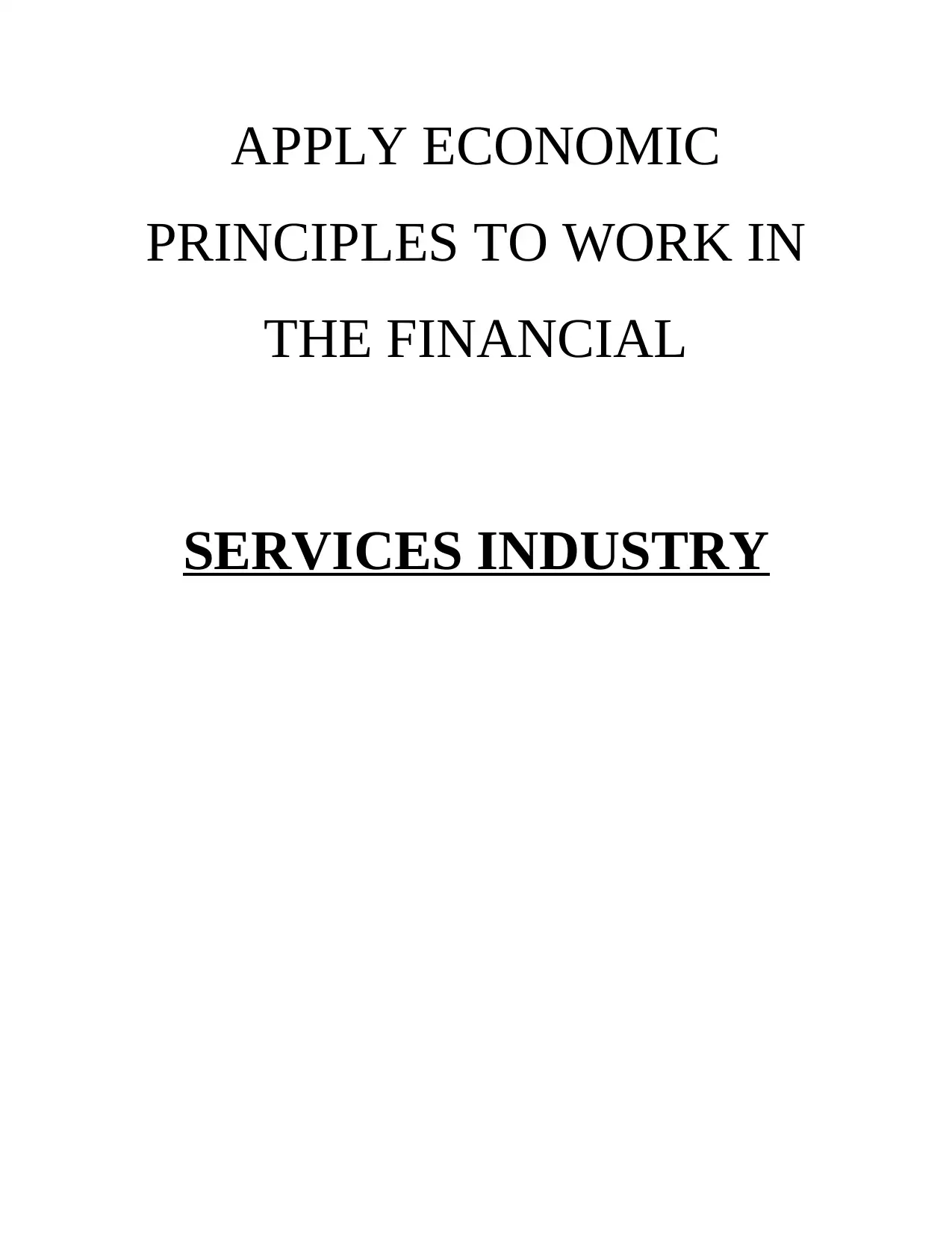
APPLY ECONOMIC
PRINCIPLES TO WORK IN
THE FINANCIAL
SERVICES INDUSTRY
PRINCIPLES TO WORK IN
THE FINANCIAL
SERVICES INDUSTRY
Paraphrase This Document
Need a fresh take? Get an instant paraphrase of this document with our AI Paraphraser
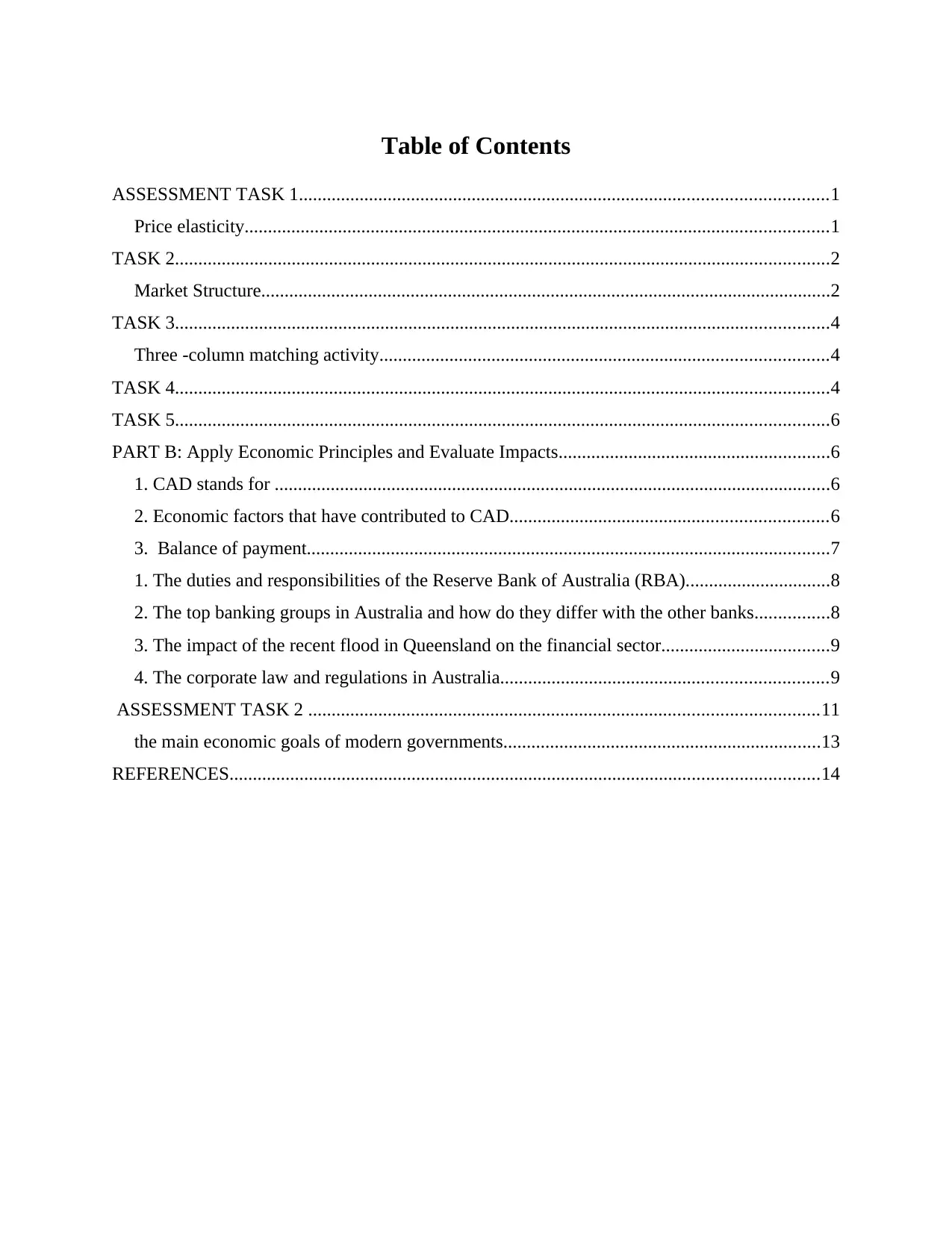
Table of Contents
ASSESSMENT TASK 1.................................................................................................................1
Price elasticity.............................................................................................................................1
TASK 2............................................................................................................................................2
Market Structure..........................................................................................................................2
TASK 3............................................................................................................................................4
Three -column matching activity................................................................................................4
TASK 4............................................................................................................................................4
TASK 5............................................................................................................................................6
PART B: Apply Economic Principles and Evaluate Impacts..........................................................6
1. CAD stands for .......................................................................................................................6
2. Economic factors that have contributed to CAD....................................................................6
3. Balance of payment................................................................................................................7
1. The duties and responsibilities of the Reserve Bank of Australia (RBA)...............................8
2. The top banking groups in Australia and how do they differ with the other banks................8
3. The impact of the recent flood in Queensland on the financial sector....................................9
4. The corporate law and regulations in Australia......................................................................9
ASSESSMENT TASK 2 .............................................................................................................11
the main economic goals of modern governments....................................................................13
REFERENCES..............................................................................................................................14
ASSESSMENT TASK 1.................................................................................................................1
Price elasticity.............................................................................................................................1
TASK 2............................................................................................................................................2
Market Structure..........................................................................................................................2
TASK 3............................................................................................................................................4
Three -column matching activity................................................................................................4
TASK 4............................................................................................................................................4
TASK 5............................................................................................................................................6
PART B: Apply Economic Principles and Evaluate Impacts..........................................................6
1. CAD stands for .......................................................................................................................6
2. Economic factors that have contributed to CAD....................................................................6
3. Balance of payment................................................................................................................7
1. The duties and responsibilities of the Reserve Bank of Australia (RBA)...............................8
2. The top banking groups in Australia and how do they differ with the other banks................8
3. The impact of the recent flood in Queensland on the financial sector....................................9
4. The corporate law and regulations in Australia......................................................................9
ASSESSMENT TASK 2 .............................................................................................................11
the main economic goals of modern governments....................................................................13
REFERENCES..............................................................................................................................14
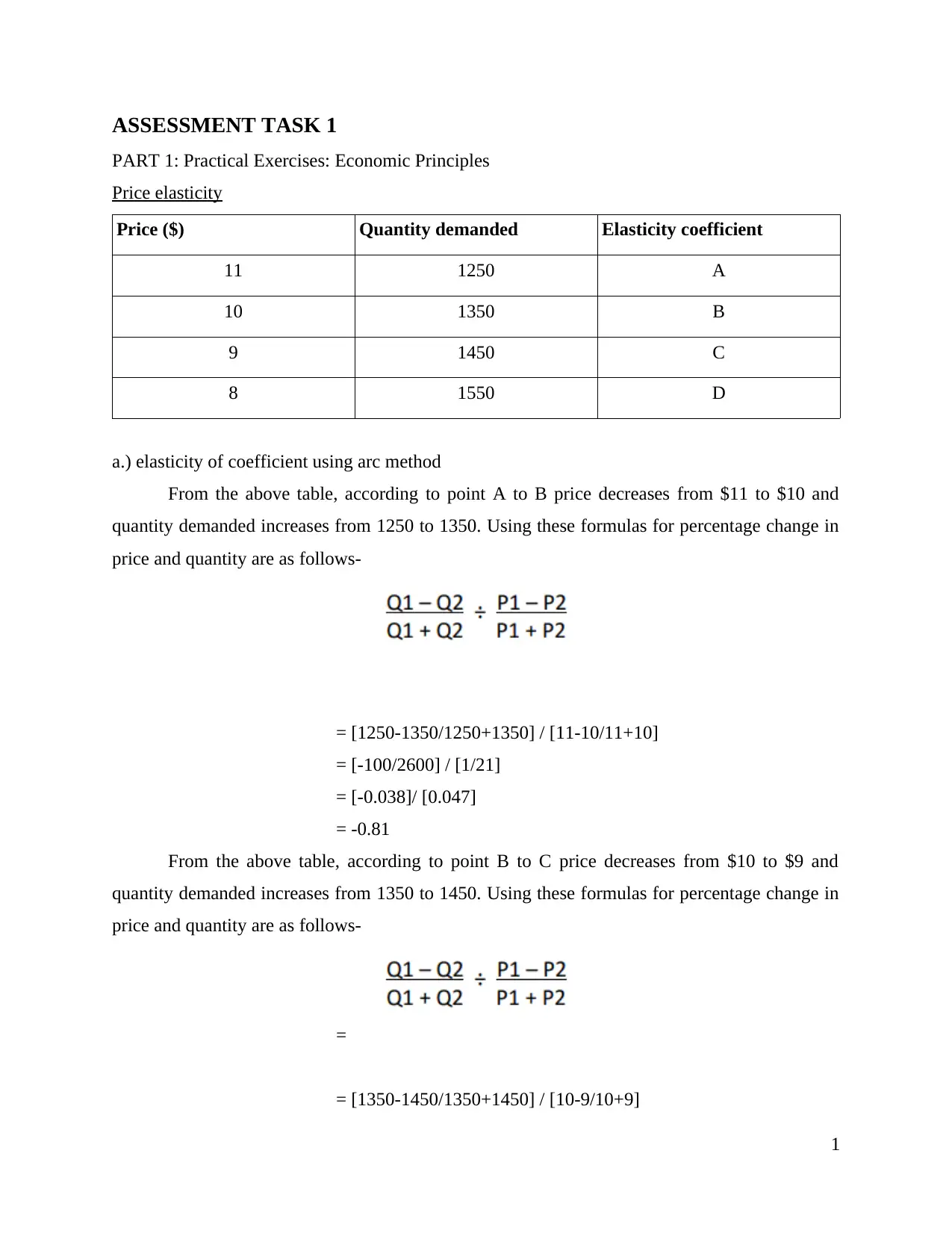
ASSESSMENT TASK 1
PART 1: Practical Exercises: Economic Principles
Price elasticity
Price ($) Quantity demanded Elasticity coefficient
11 1250 A
10 1350 B
9 1450 C
8 1550 D
a.) elasticity of coefficient using arc method
From the above table, according to point A to B price decreases from $11 to $10 and
quantity demanded increases from 1250 to 1350. Using these formulas for percentage change in
price and quantity are as follows-
= [1250-1350/1250+1350] / [11-10/11+10]
= [-100/2600] / [1/21]
= [-0.038]/ [0.047]
= -0.81
From the above table, according to point B to C price decreases from $10 to $9 and
quantity demanded increases from 1350 to 1450. Using these formulas for percentage change in
price and quantity are as follows-
=
= [1350-1450/1350+1450] / [10-9/10+9]
1
PART 1: Practical Exercises: Economic Principles
Price elasticity
Price ($) Quantity demanded Elasticity coefficient
11 1250 A
10 1350 B
9 1450 C
8 1550 D
a.) elasticity of coefficient using arc method
From the above table, according to point A to B price decreases from $11 to $10 and
quantity demanded increases from 1250 to 1350. Using these formulas for percentage change in
price and quantity are as follows-
= [1250-1350/1250+1350] / [11-10/11+10]
= [-100/2600] / [1/21]
= [-0.038]/ [0.047]
= -0.81
From the above table, according to point B to C price decreases from $10 to $9 and
quantity demanded increases from 1350 to 1450. Using these formulas for percentage change in
price and quantity are as follows-
=
= [1350-1450/1350+1450] / [10-9/10+9]
1
⊘ This is a preview!⊘
Do you want full access?
Subscribe today to unlock all pages.

Trusted by 1+ million students worldwide
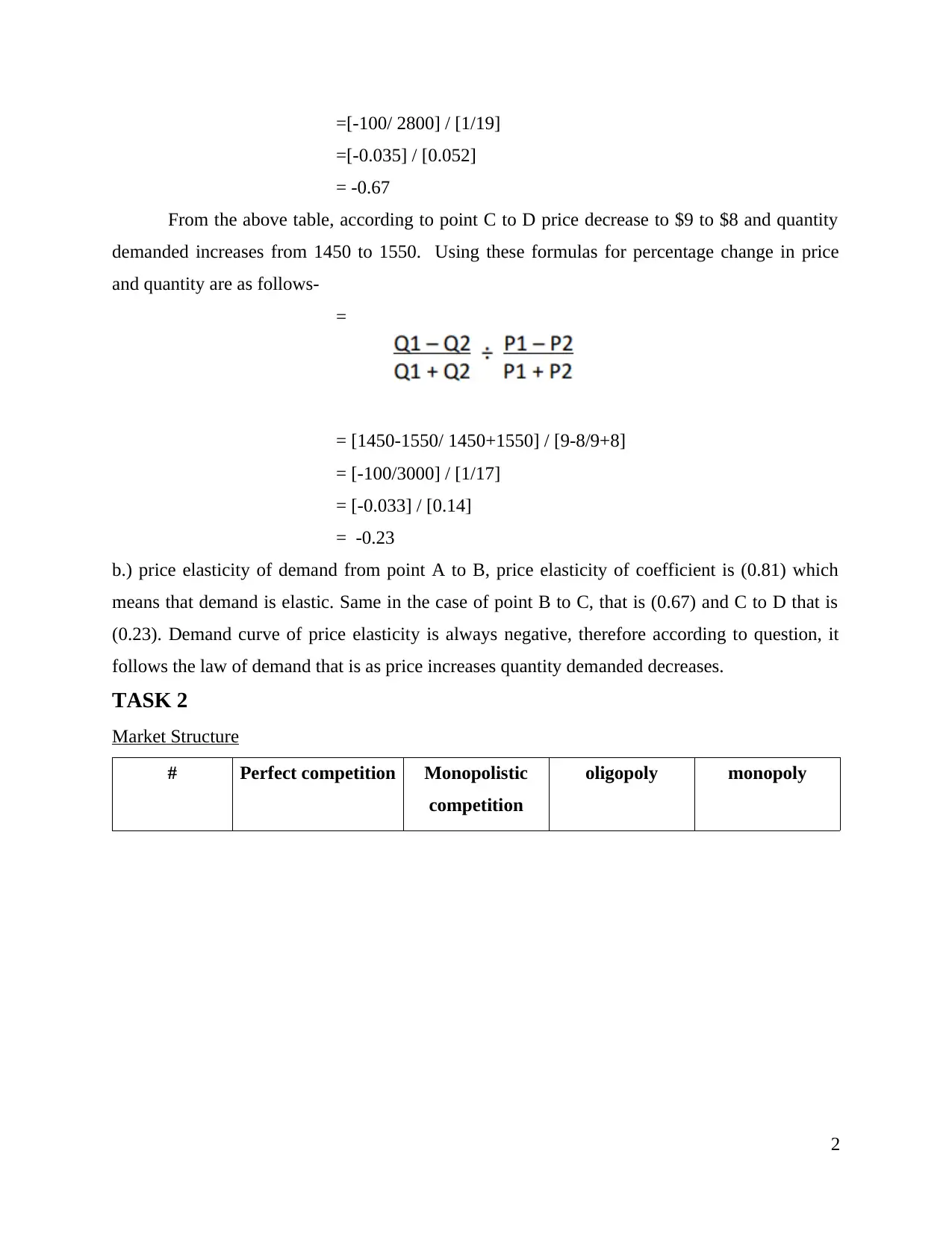
=[-100/ 2800] / [1/19]
=[-0.035] / [0.052]
= -0.67
From the above table, according to point C to D price decrease to $9 to $8 and quantity
demanded increases from 1450 to 1550. Using these formulas for percentage change in price
and quantity are as follows-
=
= [1450-1550/ 1450+1550] / [9-8/9+8]
= [-100/3000] / [1/17]
= [-0.033] / [0.14]
= -0.23
b.) price elasticity of demand from point A to B, price elasticity of coefficient is (0.81) which
means that demand is elastic. Same in the case of point B to C, that is (0.67) and C to D that is
(0.23). Demand curve of price elasticity is always negative, therefore according to question, it
follows the law of demand that is as price increases quantity demanded decreases.
TASK 2
Market Structure
# Perfect competition Monopolistic
competition
oligopoly monopoly
2
=[-0.035] / [0.052]
= -0.67
From the above table, according to point C to D price decrease to $9 to $8 and quantity
demanded increases from 1450 to 1550. Using these formulas for percentage change in price
and quantity are as follows-
=
= [1450-1550/ 1450+1550] / [9-8/9+8]
= [-100/3000] / [1/17]
= [-0.033] / [0.14]
= -0.23
b.) price elasticity of demand from point A to B, price elasticity of coefficient is (0.81) which
means that demand is elastic. Same in the case of point B to C, that is (0.67) and C to D that is
(0.23). Demand curve of price elasticity is always negative, therefore according to question, it
follows the law of demand that is as price increases quantity demanded decreases.
TASK 2
Market Structure
# Perfect competition Monopolistic
competition
oligopoly monopoly
2
Paraphrase This Document
Need a fresh take? Get an instant paraphrase of this document with our AI Paraphraser
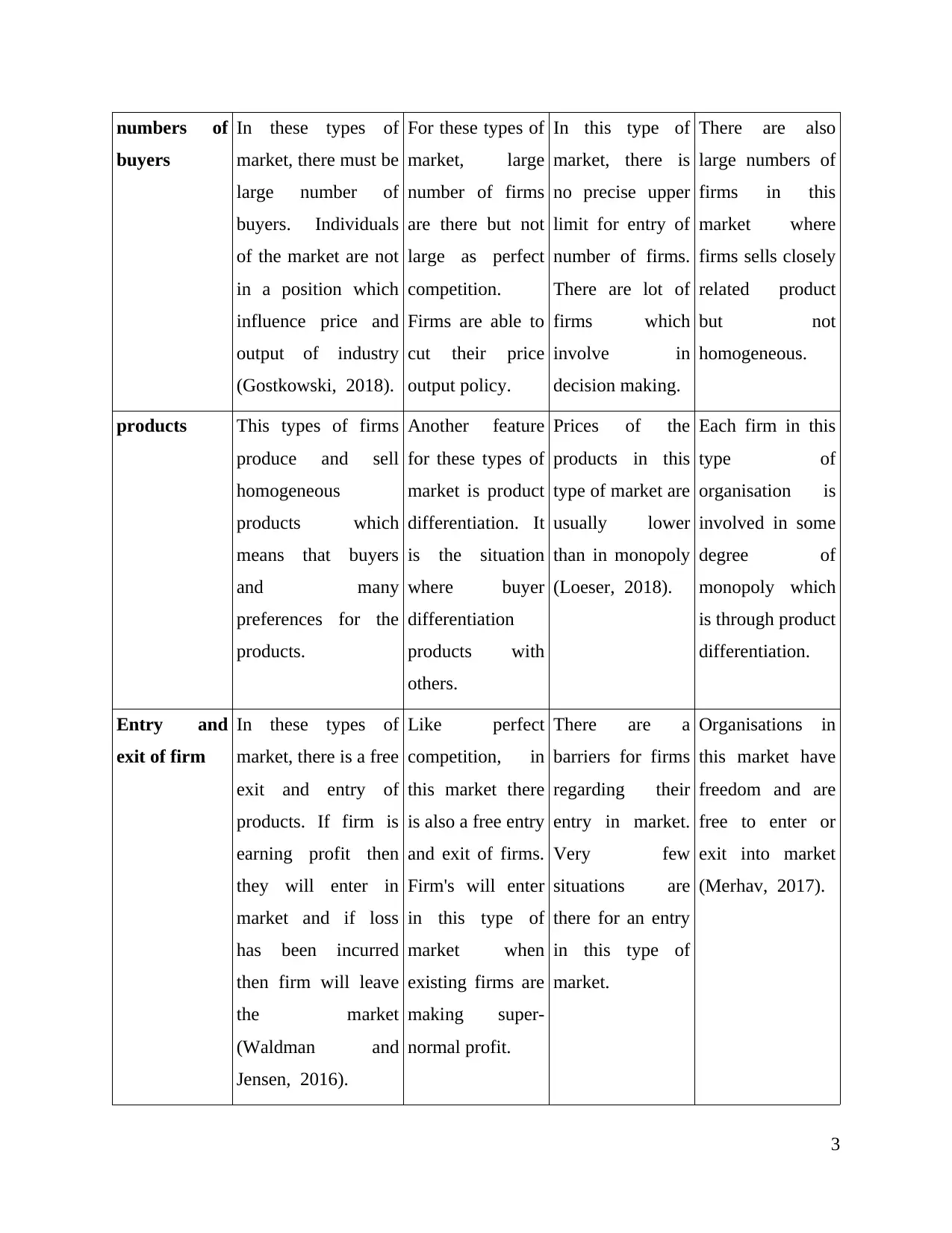
numbers of
buyers
In these types of
market, there must be
large number of
buyers. Individuals
of the market are not
in a position which
influence price and
output of industry
(Gostkowski, 2018).
For these types of
market, large
number of firms
are there but not
large as perfect
competition.
Firms are able to
cut their price
output policy.
In this type of
market, there is
no precise upper
limit for entry of
number of firms.
There are lot of
firms which
involve in
decision making.
There are also
large numbers of
firms in this
market where
firms sells closely
related product
but not
homogeneous.
products This types of firms
produce and sell
homogeneous
products which
means that buyers
and many
preferences for the
products.
Another feature
for these types of
market is product
differentiation. It
is the situation
where buyer
differentiation
products with
others.
Prices of the
products in this
type of market are
usually lower
than in monopoly
(Loeser, 2018).
Each firm in this
type of
organisation is
involved in some
degree of
monopoly which
is through product
differentiation.
Entry and
exit of firm
In these types of
market, there is a free
exit and entry of
products. If firm is
earning profit then
they will enter in
market and if loss
has been incurred
then firm will leave
the market
(Waldman and
Jensen, 2016).
Like perfect
competition, in
this market there
is also a free entry
and exit of firms.
Firm's will enter
in this type of
market when
existing firms are
making super-
normal profit.
There are a
barriers for firms
regarding their
entry in market.
Very few
situations are
there for an entry
in this type of
market.
Organisations in
this market have
freedom and are
free to enter or
exit into market
(Merhav, 2017).
3
buyers
In these types of
market, there must be
large number of
buyers. Individuals
of the market are not
in a position which
influence price and
output of industry
(Gostkowski, 2018).
For these types of
market, large
number of firms
are there but not
large as perfect
competition.
Firms are able to
cut their price
output policy.
In this type of
market, there is
no precise upper
limit for entry of
number of firms.
There are lot of
firms which
involve in
decision making.
There are also
large numbers of
firms in this
market where
firms sells closely
related product
but not
homogeneous.
products This types of firms
produce and sell
homogeneous
products which
means that buyers
and many
preferences for the
products.
Another feature
for these types of
market is product
differentiation. It
is the situation
where buyer
differentiation
products with
others.
Prices of the
products in this
type of market are
usually lower
than in monopoly
(Loeser, 2018).
Each firm in this
type of
organisation is
involved in some
degree of
monopoly which
is through product
differentiation.
Entry and
exit of firm
In these types of
market, there is a free
exit and entry of
products. If firm is
earning profit then
they will enter in
market and if loss
has been incurred
then firm will leave
the market
(Waldman and
Jensen, 2016).
Like perfect
competition, in
this market there
is also a free entry
and exit of firms.
Firm's will enter
in this type of
market when
existing firms are
making super-
normal profit.
There are a
barriers for firms
regarding their
entry in market.
Very few
situations are
there for an entry
in this type of
market.
Organisations in
this market have
freedom and are
free to enter or
exit into market
(Merhav, 2017).
3
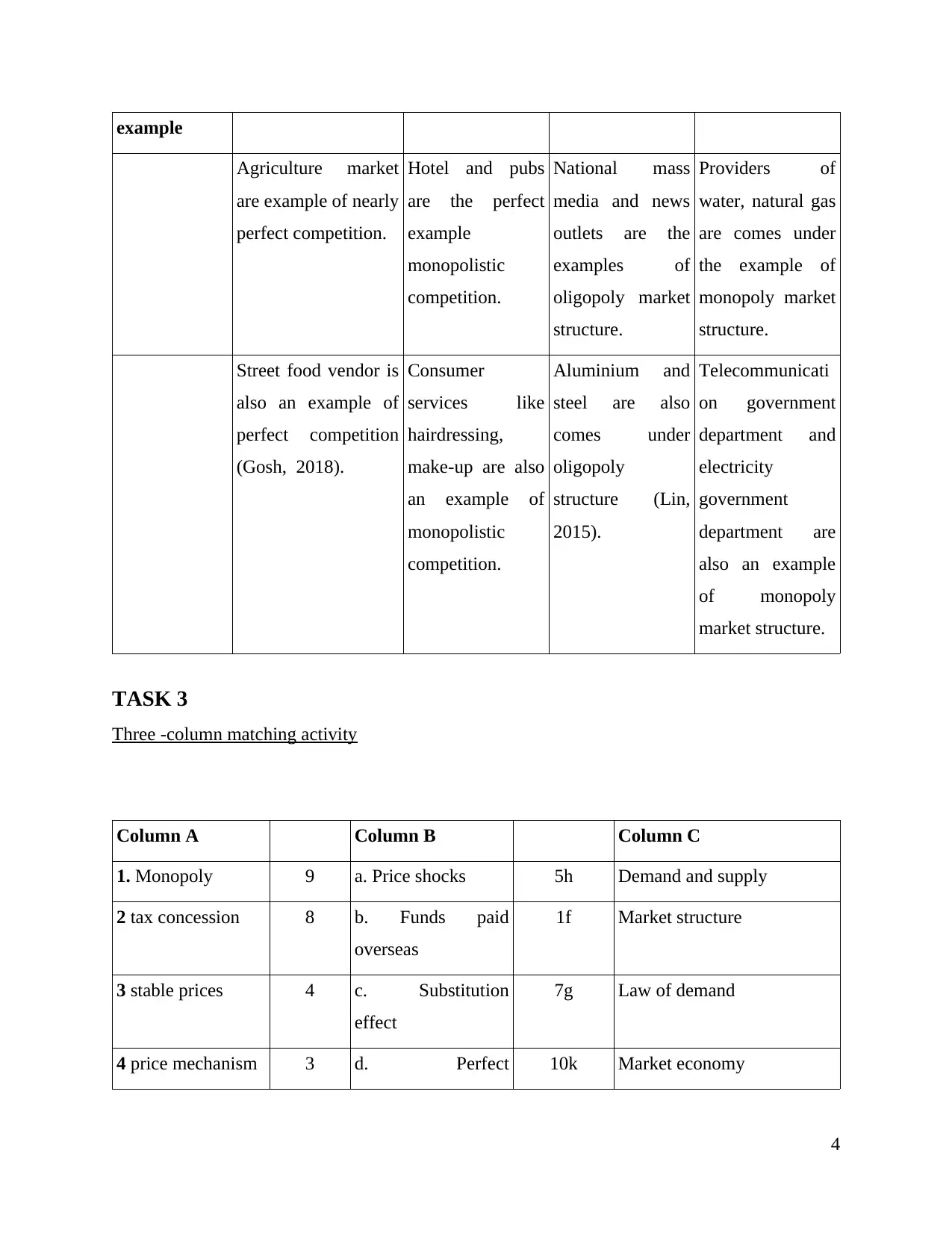
example
Agriculture market
are example of nearly
perfect competition.
Hotel and pubs
are the perfect
example
monopolistic
competition.
National mass
media and news
outlets are the
examples of
oligopoly market
structure.
Providers of
water, natural gas
are comes under
the example of
monopoly market
structure.
Street food vendor is
also an example of
perfect competition
(Gosh, 2018).
Consumer
services like
hairdressing,
make-up are also
an example of
monopolistic
competition.
Aluminium and
steel are also
comes under
oligopoly
structure (Lin,
2015).
Telecommunicati
on government
department and
electricity
government
department are
also an example
of monopoly
market structure.
TASK 3
Three -column matching activity
Column A Column B Column C
1. Monopoly 9 a. Price shocks 5h Demand and supply
2 tax concession 8 b. Funds paid
overseas
1f Market structure
3 stable prices 4 c. Substitution
effect
7g Law of demand
4 price mechanism 3 d. Perfect 10k Market economy
4
Agriculture market
are example of nearly
perfect competition.
Hotel and pubs
are the perfect
example
monopolistic
competition.
National mass
media and news
outlets are the
examples of
oligopoly market
structure.
Providers of
water, natural gas
are comes under
the example of
monopoly market
structure.
Street food vendor is
also an example of
perfect competition
(Gosh, 2018).
Consumer
services like
hairdressing,
make-up are also
an example of
monopolistic
competition.
Aluminium and
steel are also
comes under
oligopoly
structure (Lin,
2015).
Telecommunicati
on government
department and
electricity
government
department are
also an example
of monopoly
market structure.
TASK 3
Three -column matching activity
Column A Column B Column C
1. Monopoly 9 a. Price shocks 5h Demand and supply
2 tax concession 8 b. Funds paid
overseas
1f Market structure
3 stable prices 4 c. Substitution
effect
7g Law of demand
4 price mechanism 3 d. Perfect 10k Market economy
4
⊘ This is a preview!⊘
Do you want full access?
Subscribe today to unlock all pages.

Trusted by 1+ million students worldwide
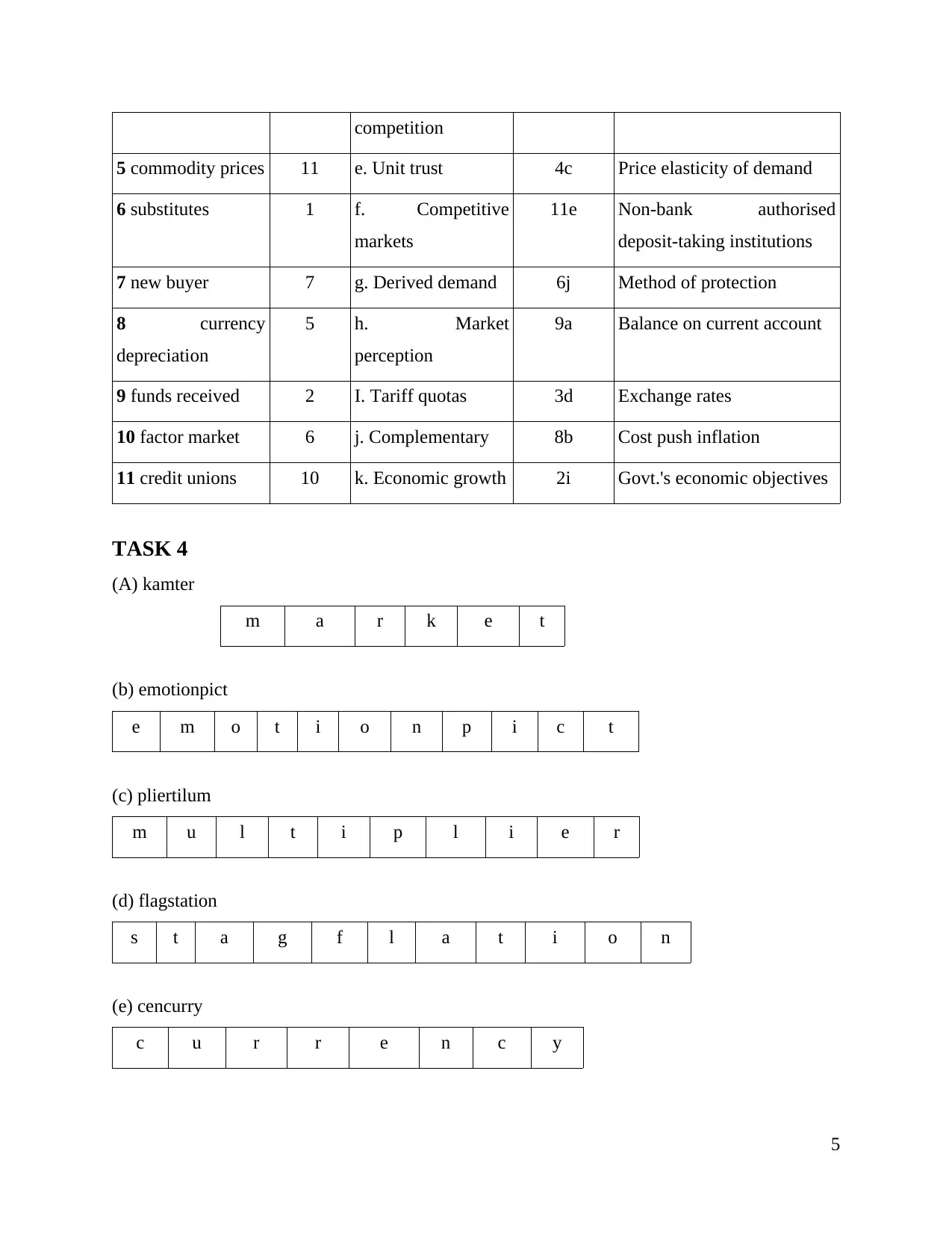
competition
5 commodity prices 11 e. Unit trust 4c Price elasticity of demand
6 substitutes 1 f. Competitive
markets
11e Non-bank authorised
deposit-taking institutions
7 new buyer 7 g. Derived demand 6j Method of protection
8 currency
depreciation
5 h. Market
perception
9a Balance on current account
9 funds received 2 I. Tariff quotas 3d Exchange rates
10 factor market 6 j. Complementary 8b Cost push inflation
11 credit unions 10 k. Economic growth 2i Govt.'s economic objectives
TASK 4
(A) kamter
m a r k e t
(b) emotionpict
e m o t i o n p i c t
(c) pliertilum
m u l t i p l i e r
(d) flagstation
s t a g f l a t i o n
(e) cencurry
c u r r e n c y
5
5 commodity prices 11 e. Unit trust 4c Price elasticity of demand
6 substitutes 1 f. Competitive
markets
11e Non-bank authorised
deposit-taking institutions
7 new buyer 7 g. Derived demand 6j Method of protection
8 currency
depreciation
5 h. Market
perception
9a Balance on current account
9 funds received 2 I. Tariff quotas 3d Exchange rates
10 factor market 6 j. Complementary 8b Cost push inflation
11 credit unions 10 k. Economic growth 2i Govt.'s economic objectives
TASK 4
(A) kamter
m a r k e t
(b) emotionpict
e m o t i o n p i c t
(c) pliertilum
m u l t i p l i e r
(d) flagstation
s t a g f l a t i o n
(e) cencurry
c u r r e n c y
5
Paraphrase This Document
Need a fresh take? Get an instant paraphrase of this document with our AI Paraphraser
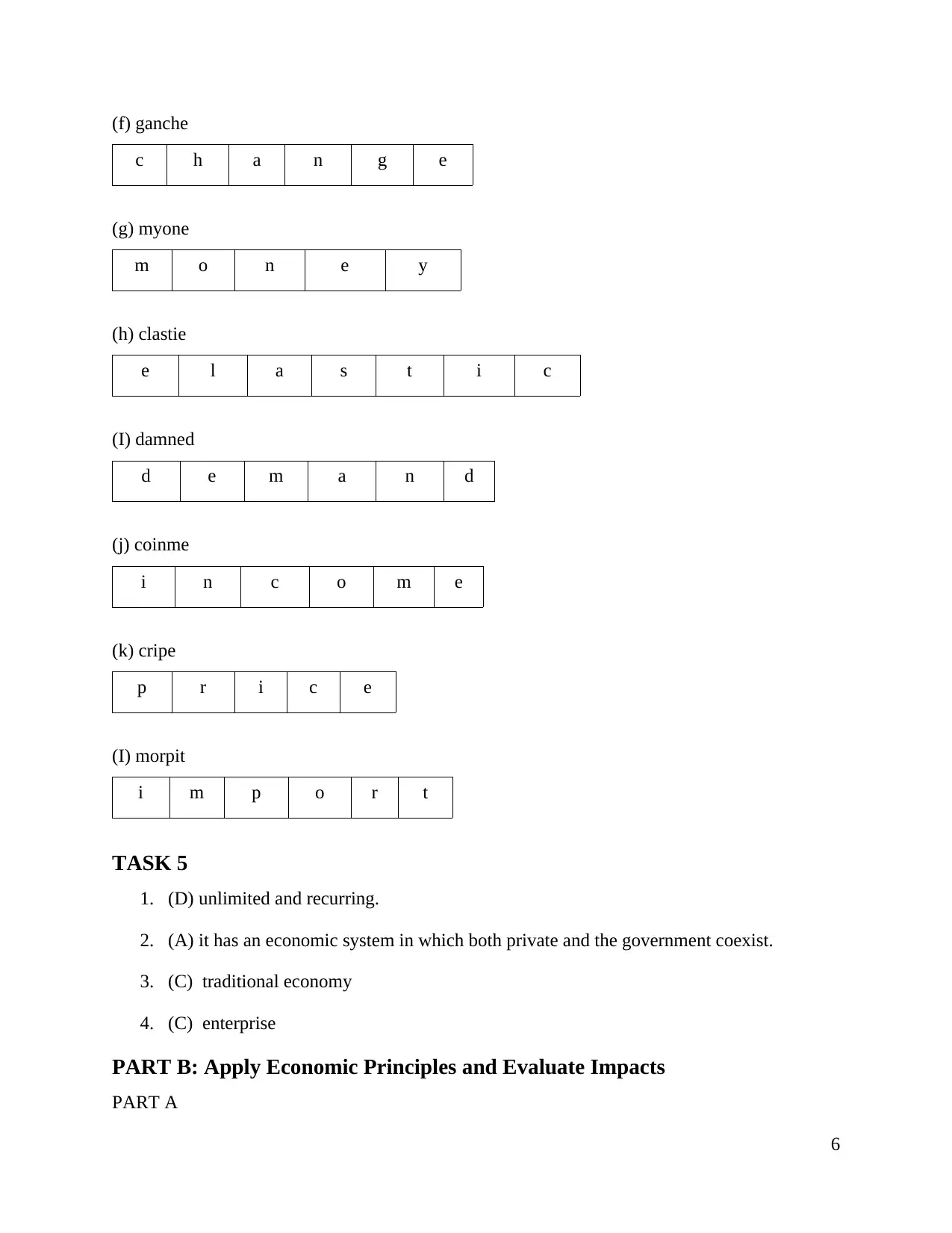
(f) ganche
c h a n g e
(g) myone
m o n e y
(h) clastie
e l a s t i c
(I) damned
d e m a n d
(j) coinme
i n c o m e
(k) cripe
p r i c e
(I) morpit
i m p o r t
TASK 5
1. (D) unlimited and recurring.
2. (A) it has an economic system in which both private and the government coexist.
3. (C) traditional economy
4. (C) enterprise
PART B: Apply Economic Principles and Evaluate Impacts
PART A
6
c h a n g e
(g) myone
m o n e y
(h) clastie
e l a s t i c
(I) damned
d e m a n d
(j) coinme
i n c o m e
(k) cripe
p r i c e
(I) morpit
i m p o r t
TASK 5
1. (D) unlimited and recurring.
2. (A) it has an economic system in which both private and the government coexist.
3. (C) traditional economy
4. (C) enterprise
PART B: Apply Economic Principles and Evaluate Impacts
PART A
6
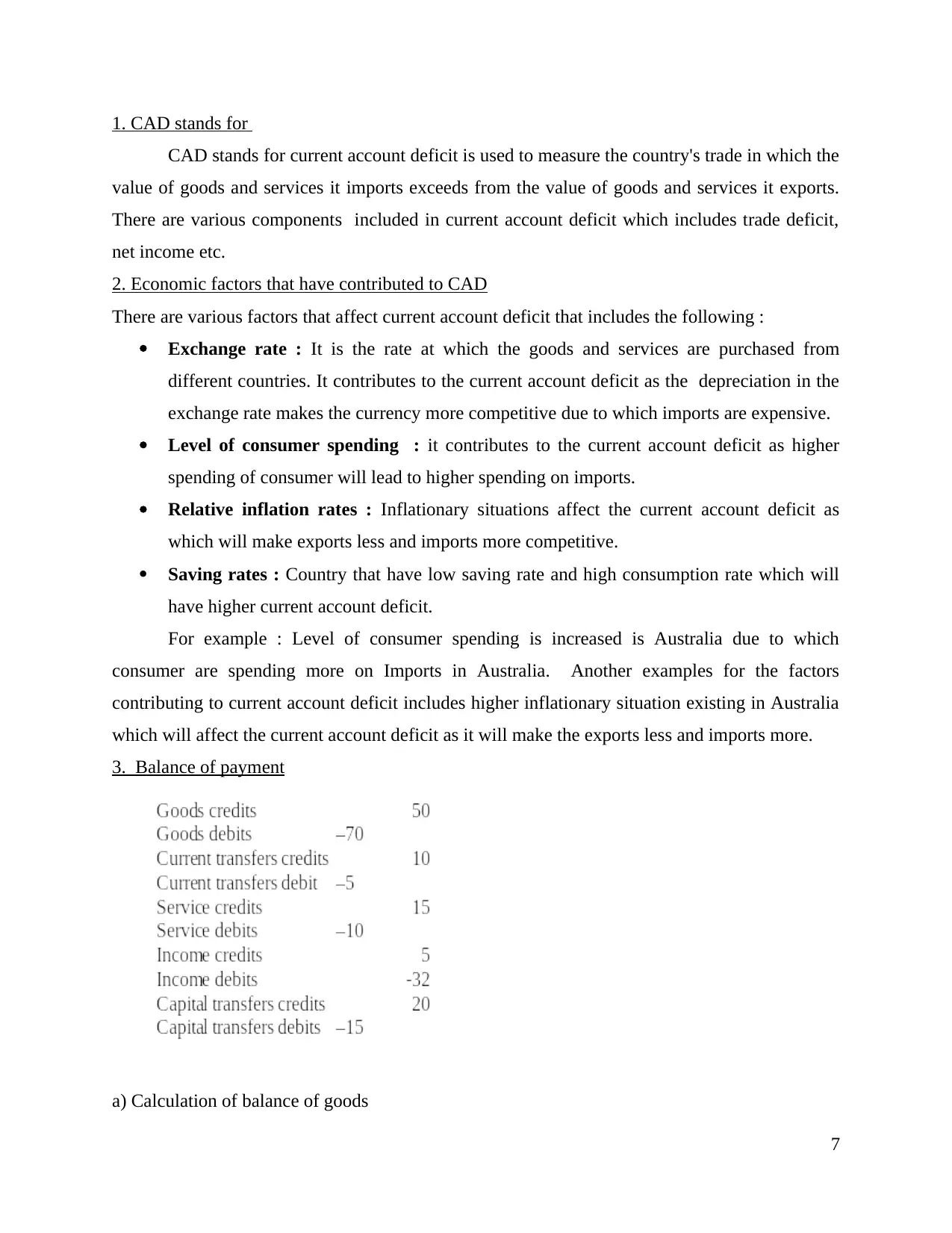
1. CAD stands for
CAD stands for current account deficit is used to measure the country's trade in which the
value of goods and services it imports exceeds from the value of goods and services it exports.
There are various components included in current account deficit which includes trade deficit,
net income etc.
2. Economic factors that have contributed to CAD
There are various factors that affect current account deficit that includes the following :
Exchange rate : It is the rate at which the goods and services are purchased from
different countries. It contributes to the current account deficit as the depreciation in the
exchange rate makes the currency more competitive due to which imports are expensive.
Level of consumer spending : it contributes to the current account deficit as higher
spending of consumer will lead to higher spending on imports.
Relative inflation rates : Inflationary situations affect the current account deficit as
which will make exports less and imports more competitive.
Saving rates : Country that have low saving rate and high consumption rate which will
have higher current account deficit.
For example : Level of consumer spending is increased is Australia due to which
consumer are spending more on Imports in Australia. Another examples for the factors
contributing to current account deficit includes higher inflationary situation existing in Australia
which will affect the current account deficit as it will make the exports less and imports more.
3. Balance of payment
a) Calculation of balance of goods
7
CAD stands for current account deficit is used to measure the country's trade in which the
value of goods and services it imports exceeds from the value of goods and services it exports.
There are various components included in current account deficit which includes trade deficit,
net income etc.
2. Economic factors that have contributed to CAD
There are various factors that affect current account deficit that includes the following :
Exchange rate : It is the rate at which the goods and services are purchased from
different countries. It contributes to the current account deficit as the depreciation in the
exchange rate makes the currency more competitive due to which imports are expensive.
Level of consumer spending : it contributes to the current account deficit as higher
spending of consumer will lead to higher spending on imports.
Relative inflation rates : Inflationary situations affect the current account deficit as
which will make exports less and imports more competitive.
Saving rates : Country that have low saving rate and high consumption rate which will
have higher current account deficit.
For example : Level of consumer spending is increased is Australia due to which
consumer are spending more on Imports in Australia. Another examples for the factors
contributing to current account deficit includes higher inflationary situation existing in Australia
which will affect the current account deficit as it will make the exports less and imports more.
3. Balance of payment
a) Calculation of balance of goods
7
⊘ This is a preview!⊘
Do you want full access?
Subscribe today to unlock all pages.

Trusted by 1+ million students worldwide
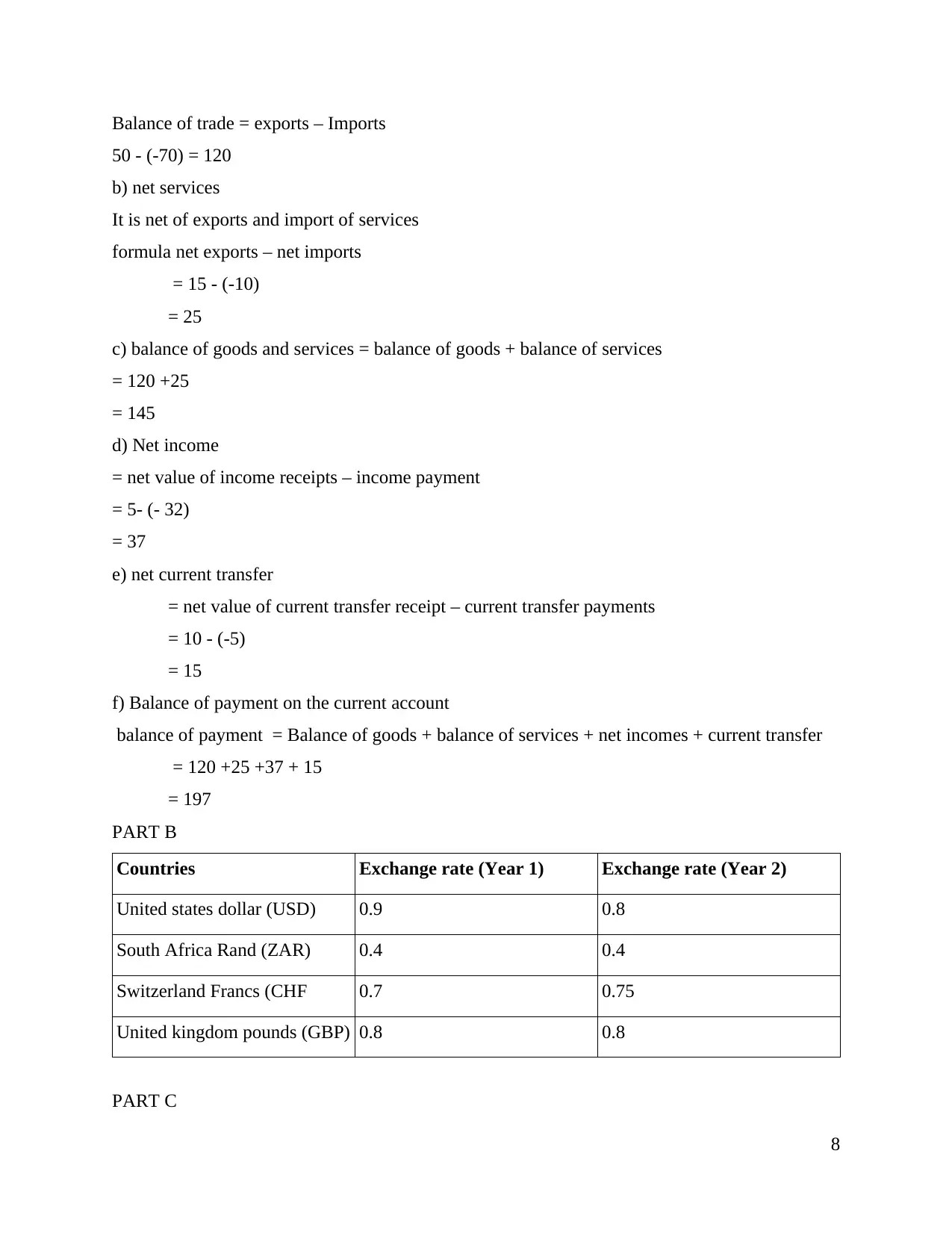
Balance of trade = exports – Imports
50 - (-70) = 120
b) net services
It is net of exports and import of services
formula net exports – net imports
= 15 - (-10)
= 25
c) balance of goods and services = balance of goods + balance of services
= 120 +25
= 145
d) Net income
= net value of income receipts – income payment
= 5- (- 32)
= 37
e) net current transfer
= net value of current transfer receipt – current transfer payments
= 10 - (-5)
= 15
f) Balance of payment on the current account
balance of payment = Balance of goods + balance of services + net incomes + current transfer
= 120 +25 +37 + 15
= 197
PART B
Countries Exchange rate (Year 1) Exchange rate (Year 2)
United states dollar (USD) 0.9 0.8
South Africa Rand (ZAR) 0.4 0.4
Switzerland Francs (CHF 0.7 0.75
United kingdom pounds (GBP) 0.8 0.8
PART C
8
50 - (-70) = 120
b) net services
It is net of exports and import of services
formula net exports – net imports
= 15 - (-10)
= 25
c) balance of goods and services = balance of goods + balance of services
= 120 +25
= 145
d) Net income
= net value of income receipts – income payment
= 5- (- 32)
= 37
e) net current transfer
= net value of current transfer receipt – current transfer payments
= 10 - (-5)
= 15
f) Balance of payment on the current account
balance of payment = Balance of goods + balance of services + net incomes + current transfer
= 120 +25 +37 + 15
= 197
PART B
Countries Exchange rate (Year 1) Exchange rate (Year 2)
United states dollar (USD) 0.9 0.8
South Africa Rand (ZAR) 0.4 0.4
Switzerland Francs (CHF 0.7 0.75
United kingdom pounds (GBP) 0.8 0.8
PART C
8
Paraphrase This Document
Need a fresh take? Get an instant paraphrase of this document with our AI Paraphraser
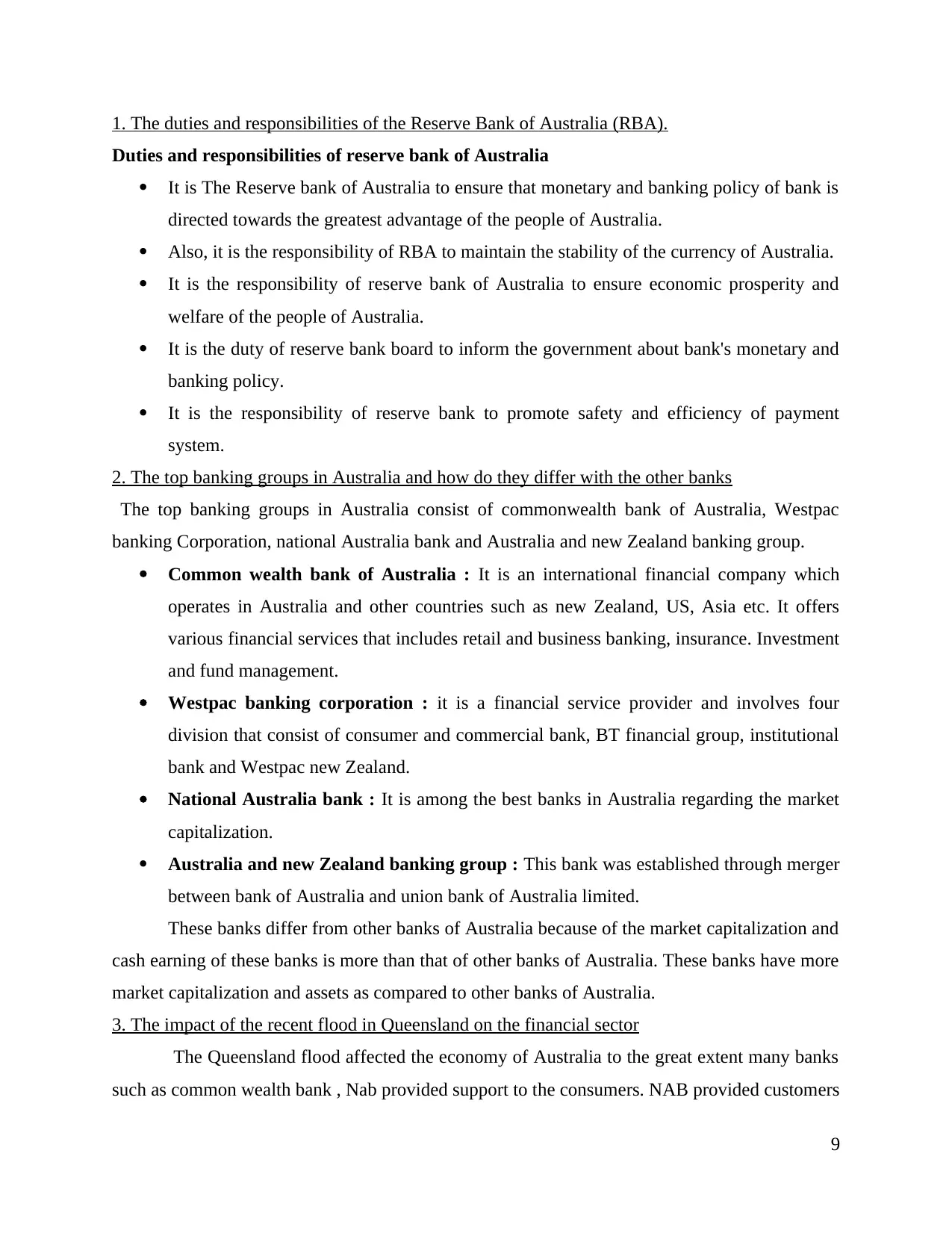
1. The duties and responsibilities of the Reserve Bank of Australia (RBA).
Duties and responsibilities of reserve bank of Australia
It is The Reserve bank of Australia to ensure that monetary and banking policy of bank is
directed towards the greatest advantage of the people of Australia.
Also, it is the responsibility of RBA to maintain the stability of the currency of Australia.
It is the responsibility of reserve bank of Australia to ensure economic prosperity and
welfare of the people of Australia.
It is the duty of reserve bank board to inform the government about bank's monetary and
banking policy.
It is the responsibility of reserve bank to promote safety and efficiency of payment
system.
2. The top banking groups in Australia and how do they differ with the other banks
The top banking groups in Australia consist of commonwealth bank of Australia, Westpac
banking Corporation, national Australia bank and Australia and new Zealand banking group.
Common wealth bank of Australia : It is an international financial company which
operates in Australia and other countries such as new Zealand, US, Asia etc. It offers
various financial services that includes retail and business banking, insurance. Investment
and fund management.
Westpac banking corporation : it is a financial service provider and involves four
division that consist of consumer and commercial bank, BT financial group, institutional
bank and Westpac new Zealand.
National Australia bank : It is among the best banks in Australia regarding the market
capitalization.
Australia and new Zealand banking group : This bank was established through merger
between bank of Australia and union bank of Australia limited.
These banks differ from other banks of Australia because of the market capitalization and
cash earning of these banks is more than that of other banks of Australia. These banks have more
market capitalization and assets as compared to other banks of Australia.
3. The impact of the recent flood in Queensland on the financial sector
The Queensland flood affected the economy of Australia to the great extent many banks
such as common wealth bank , Nab provided support to the consumers. NAB provided customers
9
Duties and responsibilities of reserve bank of Australia
It is The Reserve bank of Australia to ensure that monetary and banking policy of bank is
directed towards the greatest advantage of the people of Australia.
Also, it is the responsibility of RBA to maintain the stability of the currency of Australia.
It is the responsibility of reserve bank of Australia to ensure economic prosperity and
welfare of the people of Australia.
It is the duty of reserve bank board to inform the government about bank's monetary and
banking policy.
It is the responsibility of reserve bank to promote safety and efficiency of payment
system.
2. The top banking groups in Australia and how do they differ with the other banks
The top banking groups in Australia consist of commonwealth bank of Australia, Westpac
banking Corporation, national Australia bank and Australia and new Zealand banking group.
Common wealth bank of Australia : It is an international financial company which
operates in Australia and other countries such as new Zealand, US, Asia etc. It offers
various financial services that includes retail and business banking, insurance. Investment
and fund management.
Westpac banking corporation : it is a financial service provider and involves four
division that consist of consumer and commercial bank, BT financial group, institutional
bank and Westpac new Zealand.
National Australia bank : It is among the best banks in Australia regarding the market
capitalization.
Australia and new Zealand banking group : This bank was established through merger
between bank of Australia and union bank of Australia limited.
These banks differ from other banks of Australia because of the market capitalization and
cash earning of these banks is more than that of other banks of Australia. These banks have more
market capitalization and assets as compared to other banks of Australia.
3. The impact of the recent flood in Queensland on the financial sector
The Queensland flood affected the economy of Australia to the great extent many banks
such as common wealth bank , Nab provided support to the consumers. NAB provided customers
9
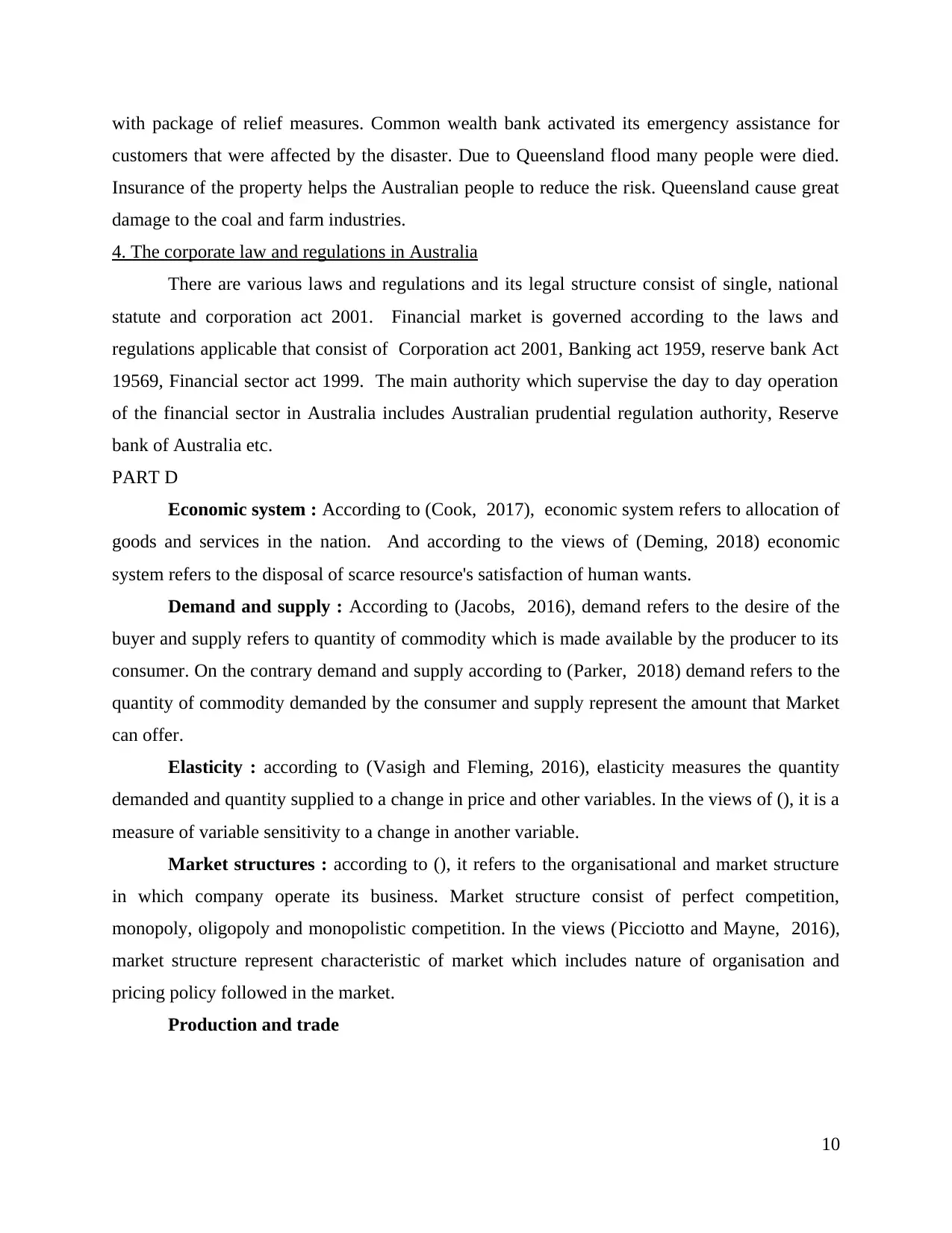
with package of relief measures. Common wealth bank activated its emergency assistance for
customers that were affected by the disaster. Due to Queensland flood many people were died.
Insurance of the property helps the Australian people to reduce the risk. Queensland cause great
damage to the coal and farm industries.
4. The corporate law and regulations in Australia
There are various laws and regulations and its legal structure consist of single, national
statute and corporation act 2001. Financial market is governed according to the laws and
regulations applicable that consist of Corporation act 2001, Banking act 1959, reserve bank Act
19569, Financial sector act 1999. The main authority which supervise the day to day operation
of the financial sector in Australia includes Australian prudential regulation authority, Reserve
bank of Australia etc.
PART D
Economic system : According to (Cook, 2017), economic system refers to allocation of
goods and services in the nation. And according to the views of (Deming, 2018) economic
system refers to the disposal of scarce resource's satisfaction of human wants.
Demand and supply : According to (Jacobs, 2016), demand refers to the desire of the
buyer and supply refers to quantity of commodity which is made available by the producer to its
consumer. On the contrary demand and supply according to (Parker, 2018) demand refers to the
quantity of commodity demanded by the consumer and supply represent the amount that Market
can offer.
Elasticity : according to (Vasigh and Fleming, 2016), elasticity measures the quantity
demanded and quantity supplied to a change in price and other variables. In the views of (), it is a
measure of variable sensitivity to a change in another variable.
Market structures : according to (), it refers to the organisational and market structure
in which company operate its business. Market structure consist of perfect competition,
monopoly, oligopoly and monopolistic competition. In the views (Picciotto and Mayne, 2016),
market structure represent characteristic of market which includes nature of organisation and
pricing policy followed in the market.
Production and trade
10
customers that were affected by the disaster. Due to Queensland flood many people were died.
Insurance of the property helps the Australian people to reduce the risk. Queensland cause great
damage to the coal and farm industries.
4. The corporate law and regulations in Australia
There are various laws and regulations and its legal structure consist of single, national
statute and corporation act 2001. Financial market is governed according to the laws and
regulations applicable that consist of Corporation act 2001, Banking act 1959, reserve bank Act
19569, Financial sector act 1999. The main authority which supervise the day to day operation
of the financial sector in Australia includes Australian prudential regulation authority, Reserve
bank of Australia etc.
PART D
Economic system : According to (Cook, 2017), economic system refers to allocation of
goods and services in the nation. And according to the views of (Deming, 2018) economic
system refers to the disposal of scarce resource's satisfaction of human wants.
Demand and supply : According to (Jacobs, 2016), demand refers to the desire of the
buyer and supply refers to quantity of commodity which is made available by the producer to its
consumer. On the contrary demand and supply according to (Parker, 2018) demand refers to the
quantity of commodity demanded by the consumer and supply represent the amount that Market
can offer.
Elasticity : according to (Vasigh and Fleming, 2016), elasticity measures the quantity
demanded and quantity supplied to a change in price and other variables. In the views of (), it is a
measure of variable sensitivity to a change in another variable.
Market structures : according to (), it refers to the organisational and market structure
in which company operate its business. Market structure consist of perfect competition,
monopoly, oligopoly and monopolistic competition. In the views (Picciotto and Mayne, 2016),
market structure represent characteristic of market which includes nature of organisation and
pricing policy followed in the market.
Production and trade
10
⊘ This is a preview!⊘
Do you want full access?
Subscribe today to unlock all pages.

Trusted by 1+ million students worldwide
1 out of 17
Related Documents
Your All-in-One AI-Powered Toolkit for Academic Success.
+13062052269
info@desklib.com
Available 24*7 on WhatsApp / Email
![[object Object]](/_next/static/media/star-bottom.7253800d.svg)
Unlock your academic potential
Copyright © 2020–2025 A2Z Services. All Rights Reserved. Developed and managed by ZUCOL.





